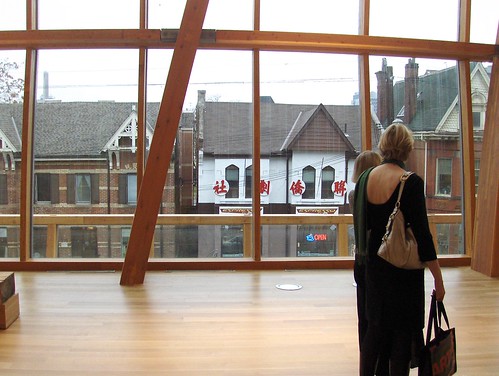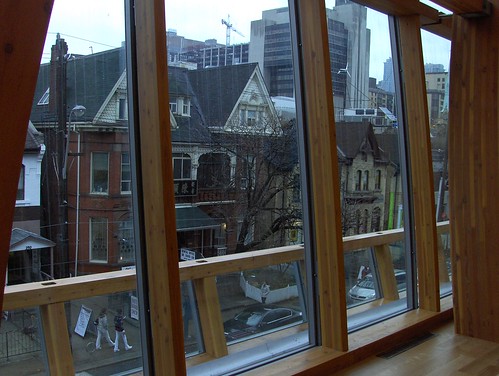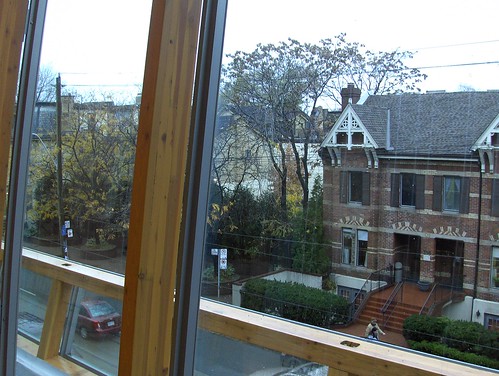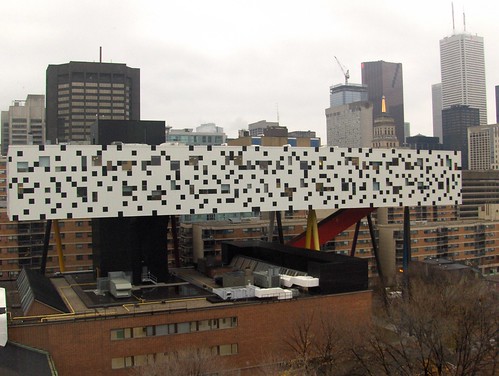
Spacing’s Shawn Micallef is the Blogger-in-Residence at the Art Gallery of Ontario’s Art Matters blog in anticipation of the grand re-opening of the new AGO. He will be cross-posting some of the entries here on Spacing Toronto. To comment on this post, click here and head over to Art Matters.
The AGO is not just for looking at. One of the things I like best about the new gallery is the way it makes Toronto — the city — as much a part of the gallery experience as the art inside. The Gehry addition (or “intervention” as I’ve been hearing it called) has opened new views to the north and south, and we’re getting to see the city in a way never seen before. To the north, the timber beams of the Galleria Italia frame the quintessential old Toronto homes along Dundas as if they are works of art themselves (perhaps they are). Apart from the occasional view stolen from somebody’s lucky second or third floor apartment, we usually don’t get to see a Toronto street from this angle.

Try this the next time you go to the AGO — walk along the south side of Dundas like you normally might do, looking at those houses along the north side. Then go into the gallery and up to the second floor and do the same thing. It’s remarkable to walk (nearly) an entire dense city block along the second floor of another building.
It’s like seeing Toronto for the first time, and simply altering the angle by a half dozen metres or so can radically change the perception of the city: I often forget to pay attention to the upper floors of these kinds of common buildings, but now I think I should do just that a lot more. So far I’ve been in this magnificent room about 5 times and have had the art pointed out and explained to me a few times but I can’t remember much about it because the city is so overwhelming (sorry, artists who made the art in Gallery Italia, I’ll pay attention to you next time for sure, it isn’t your fault).

From the back Toronto appears all around us, like we’re in the middle of the skyline rather than looking at it from afar. The concrete apartment slab directly south suddenly has a few thousand eyes a day peeping into their fishbowl lives — but as my art-companion said one day last week, “close enough to be interesting, but far enough away not to be explicit.” Looking west, the Victorian homes along Beverly facing the Grange look like the Toronto doppelganger of the famous Alamo Square view found in San Francisco (our “painted ladies” are brick and the skyline isn’t of downtown like in SF but of Etobicoke, somewhere off in the haze, rising above this wonderful stretch of Toronto urbanism).

As well, the new OCAD addition suddenly looks even more audacious (and weird and great) this close. The folks living in the apartments in the Village on the Grange on the east side of McCaul probably already know this, but now the rest of us do too. Looking out at the Grange, and Toronto, from the back Barnacle Staircase earlier today, the extent of Toronto’s development over the last few years was evident and not a little hometown pride welled up.



5 comments
In 2007, the City designated the houses on the north side of Dundas Street West opposite the AGO to acknowledge how important they would be when viewed from the new galleries.
Frank Gehry, regarding the northern faà §ade:
“It’s a kind of front porch to the city. When I stood at the entry level and a streetcar went by it was like the streetcar was in the room with me.”
Thanks for noticing it and discussing it, Shawn.
Just wondering about photos at the AGO. I know that photography isn’t allowed in the galleries, but are you allowed to take pictures out the windows?
Mg>
No, you’re not. No photography anywhere in the building.
Which is the stupidest policy ever, in my opinion.
So the photos illustrating this article would not be allowed by the average visitor.
So the AGO has sunk a ton of money into a beautiful building and isn’t allowing people to photograph it it. Stupid. Not only that, but the AGO used to allow photography inside the galleries–as long as you were photographing AGO-owned works. Which makes this new policy seem that much more extreme.
All this makes me wonder whether this new hostile policy (the AGO even has guidelines for *sketching* of artwork now!) is a string Ken Thompson attached to his donation, or simply another manifestation of the “no photography in public spaces” policy being militaristically imposed all over the UK (among other places)…or maybe they’re just more worried about losing control over potential revenue generation through artwork reproduction and pics of the now-famous Gehry building. Doesn’t explain the sketching guidelines though…
Melissa: Would they be worried about accidental damage to artworks? I know many galleries restrict sketching to pencil only (no pens, no paints). A worry about artwork reproduction might make more sense if the policy only disallowed paints, but pens?
But I strongly agree that their no-photography policy is idiotic and overcontrolling. Many of the world’s eminent galleries allow no-flash photography, and I was really disappointed to have a guard ask us to turn off our camera (no flash).
It was especially galling since many patrons were doing much more harmful things like sticking their noses literally an inch away and breathing on the paint, or running their hands on exposed canvases, or picking up things when no sign said they could. If you don’t like galleries’ restrictive policies on touch, don’t go.
(Guards also don’t like it if you sit down anywhere but on a bench, gasp! Oh yes, why sit near a railing, with a beautiful vantage point of the entire gallery, when you have a bench shoved into a dark, low corner?)